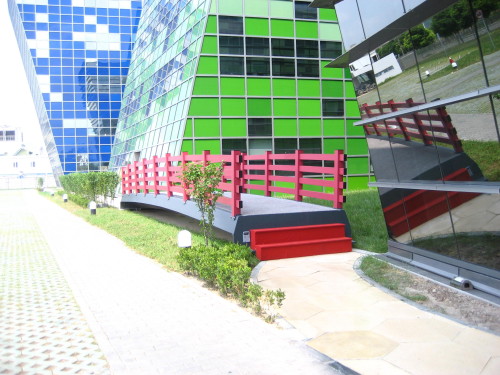
The composite pedestrian bridge was displayed at the China Composites Expo 2009 in Shanghai in September. It was designed for the Chinese market and incorporates a hand-rail modelled on a traditional Chinese footbridge.
The composite bridge was jointly developed over a four-month period by European unsaturated polyester resin producer DSM Composite Resins, and FiberCore Europe of the Netherlands, a specialist in load-bearing structures made of fibre reinforced plastic (FRP).
The bridge employs DSM's resins and FiberCore Europe’s proprietary Infracore® manufacturing technology, which been developed for heavy-load-bearing composite structures. (The InfraCore technology is patented and no further information is available at present.)
All components of the bridge are made from glass fibre reinforced plastic (GRP). The composite bridge is said to weigh about 5% of the weight of traditional concrete bridge and 20% of a steel bridge with the same dimensions and loading capacity. This lower weight means that less substantial foundations can be used, transportation is easier, and installation does not require heavy lifting equipment and is therefore quicker.
Composite bridges are also inherently buoyant, making them ideal for marine and swampy environments.
“The use of composite materials in high load bearing structures such as bridges is meeting the need for lighter-weight structures that are easier to manufacture, easier to deploy, last longer and have a lower carbon-footprint,” says Mel Foster, Director Overseas Business, FiberCore Europe.
“The new China pedestrian bridge has a lot of excess load-bearing capacity. It is not only strong enough to withstand the regulation emergency vehicle weight of 6 tons, it could even take a vehicle weight of up to 30 tons,” he adds. A recent life cycle analysis study jointly conducted by DSM Composite Resins, FiberCore and the Dutch Ministry of Economic Affairs shows that a composite bridge also has a much lower environmental impact compared to concrete, and has only one third the impact of a steel bridge.
Composite bridges are stronger and more durable than concrete or steel bridges with a life expectancy of more than 100 years, about twice as long as a conventional one.
DSM believes there is good potential for composite bridges in China.
“We are really pleased with this innovative new composite bridge and believe there is growing potential for composite materials in construction and infrastructure in China," says Henry Tang, Marketing and Sales Manager, DSM Composite Resins Asia.





